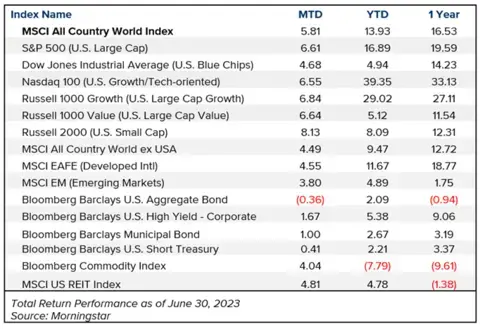For the period June 1 – June 30, 2023.
Executive Summary
Equity markets ended the second quarter strong, fueled by the resurgence of Mega-Cap Growth stocks. While the Fed may have pushed pause on further rate hikes—for now—tighter financial conditions may still be in store for the second half of the year. A mild recession may still be possible, but certain economic indicators are showing positive signs.
What Piqued Our Interest
The first half of 2023 is officially in the books, and it’s been quite a ride thus far. The bear market of 2022 feels like ancient history, as equity markets have brushed aside recession fears and are on pace for yet another historic year. There has been no shortage of fear-inducing headlines along the way—most notably the regional banking concerns beginning in March and the debt ceiling debate in May. However, June ushered in a period of relative tranquility that propelled U.S. equities to their strongest month this year.
Perhaps the most significant thing that happened in June was a highly predicted “non-event” when the Fed held off on raising rates for the first time since January of 2022. Having already slowed the pace of rate hikes to 0.25% at each of the past three meetings this year, the Fed unanimously agreed to pause after 10 straight increases that brought the benchmark interest rate from essentially 0% to 5.25%, raising the cost of borrowing on everything from mortgages, cars, credit cards, and business loans. However, the Fed did raise expectations for more rate hikes this year, suggesting through their dot plot their median estimation of two more hikes this year. Unless things significantly change between now and the next meeting on July 26, there is a high probability for another 0.25% hike this month.
A major supporting factor for additional rate hikes is the labor market, which continues to be strong in the face of weaker economic forecasts. The June payrolls report came in slightly below expectations at 209,000 jobs added (per the Bureau of Labor Statistics); however, hourly earnings ticked higher at 0.4% month-over-month, and the average workweek also edged higher. Even though the June report broke a streak of 14 consecutive headline beats—where the report surpassed consensus expectations—the labor market has yet to show signs of an economy on the brink of recession. Therefore, with core inflation still at 5.3% year-over-year, we see little chance of the Fed switching to an accommodative stance any time soon.
Market Recap

Equity markets finished the quarter on a high note as volatility, measured by the CBOE VIX index, dropped to its lowest level since January of 2020. The S&P 500 climbed another 6.61% and is now up an astonishing 16.89% at the halfway mark. The index officially entered a new bull market back on June 8, having gained 20% from its low back in October 2022. Top-performing sectors in June included cyclical sectors such as Consumer Discretionary (+12.07%), Industrials (+11.29%), and Materials (+11.05%). In another sign that the market is pricing in an economic recovery, Small Caps broadly outperformed Large Caps for the first time since before the regional banking failures, as the Russell 2000 gained 8.13% in June. The Russell 1000 Value and Growth indices were nearly identical last month, but year-to-date, Growth is still handily outperforming Value at 29.02% vs. 5.12%. International stocks fared well, as the developed EAFE Index gained 4.55%, and the Emerging Market Index added 3.80%—but both are still broadly lagging behind the U.S. in 2023. One very interesting standout is Japan, as the Nikkei 225 Index is up almost 30% through June 30, and on June 2, it finally breached its last high water mark that was reached all the way back in 1990.
On the fixed income side, rates have moved higher across the curve, as the 10-year Treasury moved from 3.60% to 3.86%, with even higher moves for 3-to-5-year bonds. The Bloomberg Barclays U.S. Aggregate Bond Index fell -0.36% for its second consecutive monthly loss and is now up just 2.09% for the year on a total-return basis. Credit spreads on high-yield bonds relative to Treasuries decreased from approximately 5.2% to 4.7% in June, driving the High-Yield Index higher by 1.67% last month. Meanwhile, tax-exempt municipal bonds gained 1.0% in June and are now higher than the Aggregate Index, even on a pre-tax basis.
Closing Thoughts
Market breadth, defined as the number of stocks participating in the market’s rally, will be a closely watched indicator in the coming months. While just seven stocks comprised the majority of performance in the first half of 2023, market breadth did show signs of improvement during the month of June, which is widely considered a positive indicator. If corporate earnings continue to broadly outperform expectations, and banking concerns continue to fade, we may be in store for broader stock market participation in the coming months.
As we look toward the second half of 2023 and beyond, our focus will remain on whether the Fed can bring inflation back to its long-term target without driving the economy into recession. At this point, it appears that either a mild recession or narrowly avoiding an economic downturn are both possible. One factor supporting the “soft landing” narrative is a notable improvement in the housing sector, which was one of the first impacted sectors when the Fed began raising rates. New housing starts hit their highest level in over a year, while starts of multifamily units hit their highest level in nearly four decades, according to the Census Bureau. If housing continues to improve and the labor market remains resilient, we may be able to brush aside recession fears for another day.

